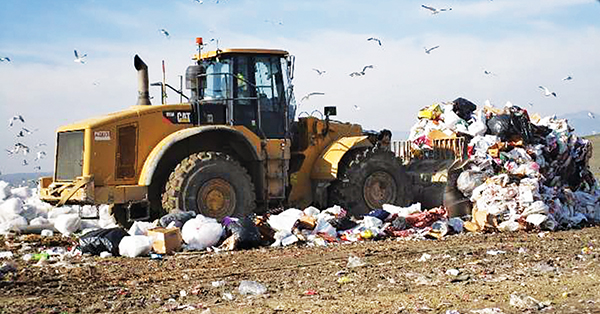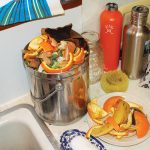
Operated by Waste Management, the Altamont Landfill in Livermore is one of the largest in Northern California. These photos of its active face were taken in January 2019 as part of a periodic inspection conducted by Alameda County. Photo courtesy CalRecycle.
Ours is a consumer economy. That’s a misleading term, isn’t it, since much of what we “consume” ends up in landfills. And although state and federal regulations have improved landfills over the last 50 years, they still pose problems. They take up space, can change the behavior of flora and fauna, and are environmentally destructive in the long run.
Some of you are already committed to the goal of Zero Waste, which means that you work hard to keep trash from going to landfills. You recycle paper, glass, and cans; you separate organic waste for composting; and you carry a reusable water bottle, coffee cup, and canvas tote bag. If that’s you, then keep up the good work! But most of us need to think more about landfills and why we need to divert as much trash as possible away from them. It may surprise you to learn that even with increased awareness of and municipal participation in recycling and composting programs, waste generation and landfill disposal are on the rise in California, according to state agency CalRecycle.
It is worth noting that our trashy ways have gotten better in the last fifty years. At least we’re not dumping our garbage in the wetlands of the San Francisco Bay anymore. From the Gold Rush until the 1970s, communities used the bay as their dumping ground until Sylvia McLaughlin, Kay Kerr, and Esther Gulick took to living rooms and boardrooms to protect it from more landfill and to inspire the birth of Save the Bay. That non-profit organization helped enable the 1965 formation of the San Francisco Bay Conservation and Development Commission, which began to regulate the use of the bay. As a result, many shoreline garbage dumps were eventually transformed into parks.
Today, there are more than a dozen landfills-turned-parks on the bay’s edges. Nick Lapis, director of advocacy for Californians Against Waste, says that most mounds and high points you see on the edge of the bay are active or inactive landfills. The Albany Bulb was a local dump until it closed in 1987 and was transformed into a popular dog-walking spot and guerilla sculpture garden. Oyster Point Park was an intertidal shore where oysters were once cultivated, and where South San Francisco later dumped and incinerated its garbage; now it’s a shoreline park. Further down in Mountain View, Google’s corporate headquarters and the Shoreline Amphitheatre are built on former dump sites.
As landfills were forced to move from the bay’s edges, the general trend was also for them to become less local and more regional. The bigger ones headed for the hills. Three large regional dumps that operate further inland are Potrero Hills Landfill in Solano County, Ox Mountain Sanitary Landfill in San Mateo County, and Altamont Landfill in Alameda County. Bayside facilities haven’t vanished completely, however, with Redwood Landfill in Novato and Newby Island Landfill in Milpitas both still in operation.
On the whole, most of the garbage generated in the Bay Area travels 25 to 40 miles, said Arthur Boone, a Zero Waste Committee member of the Sierra Club’s San Francisco Bay Chapter. Boone is eighty years old, and remembers firsthand the progression of landfills and recycling. As a Boy Scout, he and his troop made enough money recycling newspapers to buy camping gear.
The 1976 federal Resource Conservation and Recovery Act established a protocol for the nation’s disposal of waste. First there was dump-off recycling and then curbside collection. San Francisco was the first city to have a three-cart system with large bins for green waste and recycling, and a small can for garbage. “At some point there’s a click that goes off in your head. Garbage is what we don’t compost or recycle,” said Boone.
To accommodate this garbage, landfills are built to have complex stratification. Before any trash can be dumped, first a layer of clay and then a sheet of high-density polyethylene are laid down. Above that, a perforated pipe system runs through a layer of gravel to collect and divert leachate (garbage-infused tea) into sumps. Our garbage is thrown on top of these layers and covered daily by topsoil, green waste, or fabric. Once a section of landfill reaches its permitted height, layers of clay, another plastic liner, drainage material, topsoil, and vegetation are laid down. At that point, depending on your point of view, you would say “Rest in peace” or “Mea culpa” to the capped dump site.
“Rest in peace” means you’re looking on the bright side. In addition to those layers of protection, some landfills even work to improve the land to support flora and fauna. The serpentine soils at the Kirby Canyon Recycling and Disposal Facility in Morgan Hill host the world’s largest population of the bay checkerspot butterfly. When the butterflies were discovered, the facility owner, Waste Management, worked with Stanford University to develop a conservation agreement that called for setting aside 267 acres and developing a plan to ensure landfill operations wouldn’t harm the federally-endangered species. Waste Management owns 252 landfills and services 20 million people in North America, including the Altamont Landfill in Livermore. At this landfill, they put a habitat conservation easement on 1,000 acres of its 2,170-acre site.
Other than special programs, the Altamont Landfill wildlife preserve is not open to the public, but plenty of parks are built on top of old, capped garbage landfills. “They are perfectly fine as open space in the short run,” said Lapis. “But inevitably, they are environmental disasters.”
Historic landfills have issues, and modern landfills have similar issues, said Alfred Twu, Sierra Club’s Zero Waste Committee chair. One thing that’s in abundance in a landfill is plastic. “Metals and glass are easy to recycle, but it’s hard to find markets for plastic recycling because the value of plastic is low,” he said. Plastic represents what he calls “wishful recycling.” For years it went to China, but that’s an environmental timebomb since they have few environmental protections. Recently, China cut down on the amount of plastic they take. “Recyclers in the US are trying to find other countries to take the plastic, but some cities simply send it to landfills,” said Twu.
The biggest immediate problem at landfills, however, is the organic materials such as wood, paper, and food scraps that are mixed in with the trash. The wet trash biodegrades, and creates methane and other nasty gases.
Landfills can, and do, change the behavior of wildlife. California gulls offer the most dramatic example. Their breeding population increased from 24 birds in 1980 to 53,000 in 2017, according to annual counts made by the San Francisco Bay Bird Observatory. US Geological Survey scientists believe that a combination of improved nesting habitat in local salt ponds and food availability in garbage landfills resulted in what can only be seen as a population explosion. They estimate that landfill fare makes up 50 to 75 percent of breeding gulls’ diets.
Capped landfills are not stable in the long run. They are operated as “dry tombs,” said Lapis. All the moisture is taken out to stabilize the rotting garbage. But there isn’t a liner made that will last forever, he said, and once liquid gets into the mass, leachate can get into groundwater, slopes can fail, and the mass can catch on fire and burn for years. Mea culpa.
“Confidence in liners varies with how much you want to believe they will work,” said Sierra Club’s Boone. Seems as though wishful thinking about the longevity of landfill liners is similar to the “wishful recycling” of plastic.
The best way to mitigate the problems with landfills is to divert trash from going to them in the first place. That brings us to the Zero Waste programs implemented as goals in several cities in the Bay Area, of which San Francisco is leading the way in practice and performance. But we’re not there yet. “One pound in four is still going to landfills,” said Twu. “The remaining quarter is the hardest to deal with. We’ve hit a plateau of what we can divert from landfills and have to go up the food chain to change product and packaging.”
Lapis doesn’t see Zero Waste as a zero-sum game. He sees it as an “inspirational target,” similar to the goals of a manufacturing company that aspires to have no work-related injuries. They don’t expect to reach their goal one-hundred percent of the time, but they do implement protocols to increase their chances of success.
Aleta George covers open space for the Monitor.

